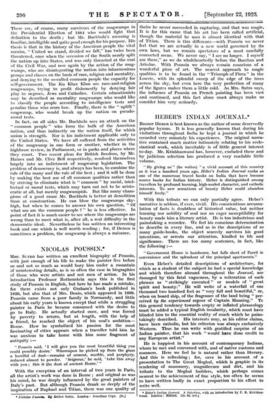HEBER'S INDIAN JOURNAL.*
Bisnor HEBER is best known as the author of some deservedly popular hymns. It is less generally known that during his visitations throughout India he kept a journal in which he recorded very minutely his experiences. The original narra- tive contained much matter intimately relating to his eccle- siastical work, which inevitably is of little general interest to-day. Mr. Krishhaswami has, however, excluded these and by judicious selection has produced a very readable little volume.
" By giving us " (he writes) " a vivid account of this country as it was a hundred years ago, Ilebcr's Indian Journal ranks as one of the numerous travel books on India that have become source books for Indian history. Heber is distinguished among travellers by profound learning, high-souled character, and catholic interests. To new sensations of beauty Heber could abandon himself freely."
With this tribute we can only partially agree. Heber's narrative is seldom, if ever, vivid. His conscientious accumu- lation of facts is doubtless of historical value, but neither learning nor nobility of soul nor an eager susceptibility for beauty made him a literary artist. He is too industrious and painstaking a recorder. We feel his conscious determination to describe in every line, and as in the descriptions of so many guide-books, the object scarcely survives his good intentions, or arrests our attention, kindled to life and significance. There are too many sentences, in fact, like the following :- "Government House is handsome, but falls short of Parcil in convenience and the splendour of the principal apartments."
Even Heber's detailed descriptions of architecture, for which as a student of the subject he had a special knowledge and which therefore abound throughout the Journal, are damaged by this fatal vagueness, by a reiteration of such phrases as " strikingly executed " or models of " great spirit and beauty." He will write of a waterfall of one thousand two hundred feet as " very full and beautiful," or, when on board ship, of the fragrance of the land being " per- ceived by the experienced organs of Captain Manning." Te this general tendency towards empty or inflated phraseology must be added a typical English insularity, which must have blinded him to the essential reality of much which he pains- takingly described. His interests may, as his editor claims, have been catholic, but his criterion was always exclusively Western. Thus he can write with gratified surprise of an Indian painter, that his work " would have done credit to any European artist."
He is happiest in his account of contemporary Indians, whom he met and conversed with, and of native customs and manners. Here we feel he is natural rather than literary. And this is refreshing ; for, save in his account of a presentation to The Great Moghul, which is graphic in its rendering of mummery, magnificence and dirt, and his tribute to the Moghul builders, which perhaps comes nearest to the achievement of fine style, too often he seems to have written badly in exact proportion to his effort to write well.
• Heber's Indian Journal. A Selection, with an introduction by P. R. KrishhaS- wamL London : Milford. [Ss. ed. netl






































 Previous page
Previous page